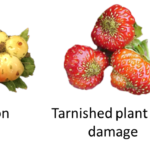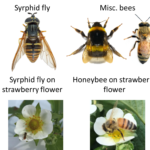Insects provide an important pollination service in many crops including strawberry. Although strawberry flowers can self-pollinate without insects, it is well known that supplemental pollination by insects can result in better formed and larger fruit. Therefore, pollination services in strawberry affects both quantity (berry size) and quality (berry shape) of yield. By evaluating strawberry fruit and insect activity, growers can determine if lack of pollination service by insects is causing yield loss.
Poor pollination of strawberry flowers results in small and malformed berries (Fig. 1). These malformations are the result of prevented berry growth around unfertilized seeds or “achenes.” In contrast, berries that are well pollinated appear larger and well-formed. However, malformation by poor pollination and damage by tarnished plant bug can appear similar in many cultivars (Fig. 1). Tarnished plant bug nymphs in particular feed on developing strawberry seeds, creating similarly misshapen fruit. It is therefore important to pair fruit rating with pollinator observations when plants are flowering to rate pollinator presence and success.
Strawberry flowers are visited by an assortment of insect groups that contribute towards pollination. Most important of these are hover flies and bees (Fig. 2). These pollinators are most active on warm and sunny days between 9 AM-12 PM. These pollinators can be scouted during this time by observing flowers of 2-3 neighboring strawberry plants for 5 minutes. During this time, watch for flower visitation by these and other insects. If one or more visits occur, pollinators are considered present.
If no pollinators are present during observation intervals, and fruit is consistently small and misshapen, poor pollination may be an issue in this field. To improve pollinator presence and success, consider spraying fewer pesticides and avoid spraying during peak flowering periods. Planting pollinator-friendly native plants is also highly attractive to bees and many other pollinating insects such as hoverflies, moths and butterflies and may recruit pollinators to target strawberry plants. See resources below for more information on pollinator-friendly plants.
Pollinator-Friendly Native Plant Lists | Xerces Society
Recommended Indiana-native Plants for Protecting Pollinators (purdue.edu)
- Figure 1. Examples of strawberry fruit with poor pollination (left), tarnished plant bug feeding damage (center) and a marketable berry (right).
- Figure 2. Common pollinators found on strawberry flowers.

